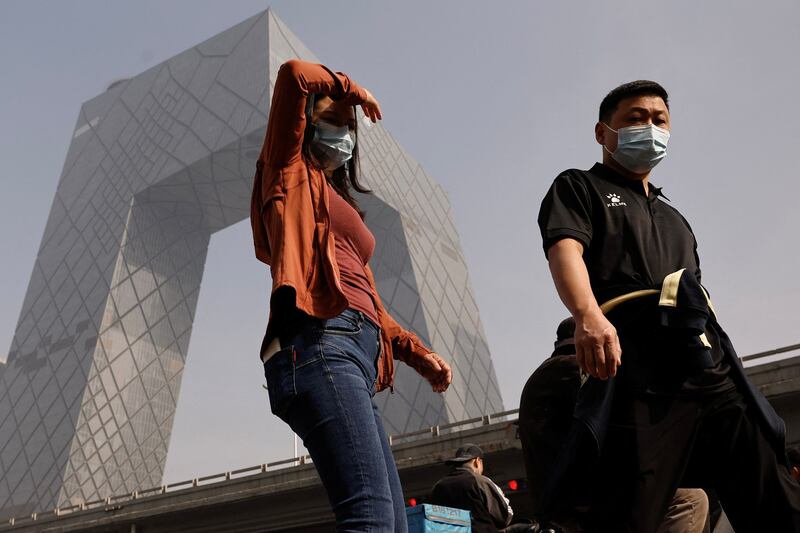Updates at 9:43 am ET on Nov. 7, 2023
Beijing and other northern Chinese cities are once more wreathed in heavy smog, with severe pollution warnings issued for the capital, along with the northern port of Tianjin and other regional cities amid a return to coal-fired power generation in a bid to kickstart the economy.
Residents of Beijing and other northern cities have been warned to expect severe pollution for at least two consecutive days, or moderate pollution for three consecutive days, affecting around 100 million people in the region.
The return of the smog comes after Chinese Communist Party leader Xi Jinping called for greater " self-reliance" amid the power cuts and rationing of the past two years. Beijing had previously closed dozens of coal-fired power plants and relocated much of its heavy industry to clear the skies as part of its successful bid to host the 2022 Winter Olympics.
State media reports said much of the recent smog has been caused by increased power consumption in the cement, brick and tile industries, as well as from heavy truck exhaust fumes.
On Nov. 1, the concentration of PM2.5 fine particulate matter, the most dangerous kind to human health, measured more than 20 times the level recommended by the World Health Organization, making it the third most polluted city in the world this week.
Qin Qi, an analyst at Finland's Centre for Research on Energy and Clean Air, said the ruling Chinese Communist Party's bid to stimulate economic growth while focusing on energy security has led to an expansion in coal-fired generation, despite the country's stated carbon goals.
"The power generation sector is the most crucial in determining whether China can achieve [its goal of] carbon neutrality by 2060," Qin said. "Its carbon emissions account for around half of total nationwide emissions."
More plants coming
Flora Champenois, an analyst at the U.S. non-profit organization Global Energy Monitor, said Beijing is still building new coal-fired power plants with a view to ensuring its energy security.
"If China keeps its fast pace in developing wind and solar power and sticks to its stated coal power development plan – reducing coal power generation despite increasing installed capacity and keeping coal power in its assigned "supporting" role – China’s dual carbon goals would not be delayed," Champenois said.

But she said China had a lot to lose by expanding coal capacity.
"Continuing to permit more coal-fired power plant capacity will either result in emissions increases, or plants sitting idle, generating losses, and perpetuating the power system’s dependence on coal," Champenois said in comments emailed to Radio Free Asia.
"As the world turns its back on new coal projects, China is making the path towards its energy transition and climate commitments more complicated and costly," she said, adding that China's goal of peaking CO2 emissions by 2030 "creates significant leeway for emissions to rise over the course of this decade."
"There is a danger that China may peak carbon emissions at a high level and make the second goal – carbon neutrality – more difficult," Champenois warned. "The rush to build new coal power plants and coal-based industrial plants represents the mentality of ‘climbing to the peak'."
"Officials and executives in China see the next five years as a window of opportunity to add new carbon-intensive capacity, which is concerning," she added.
Dorothy Mei, who heads the Global Coal Mine Tracker research project at Global Energy Monitor, agreed, saying: "China's carbon neutrality goal largely means reducing dependence on coal."
She said China has approved a slew of new coal mines across its northwestern regions including Inner Mongolia, Xinjiang, Shaanxi and Shanxi provinces, yet those regions are also being targeted for the development of clean energy.
Qin said the government has yet to make clear just how its clean energy commitments will be met.
"Right now, China is mainly controlling energy consumption, but the central government has also said the country must move towards carbon emission controls too," Qin said. "But we have yet to see any details of how this will be done, or any plans for the expansion of the carbon market."
"They have been talking about expansion, but we haven't yet seen how they will fund it, or what their next steps will be," he said.
UN promises
Xi told the U.N. General Assembly on Sept. 22, 2020, that he would ensure that carbon emissions peak before 2030, promising carbon neutrality by 2060.
In 2021, he repeated his pledge to strictly limit coal-fired power projects and coal consumption growth over the following five years, and promised not to sign any more coal-fired power export contracts.

But an unprecedented heatwave in 2021 and 2022 created a massive spike in power demand as people across the country relied on air conditioners to stay cool and safe, overloading the national grid and prompting blackouts and rationing around the country.
In response, the government started approving more coal mines and coal-fired power, citing the need to maintain energy security.
By Aug. 11, the Communist Party's People's Daily newspaper was reporting that open-pit coal mining output had exceeded 1 billion tons for the first time during 2022.
Translated by Luisetta Mudie. Edited by Malcolm Foster.
Updates with additional quotes from Champenois.

